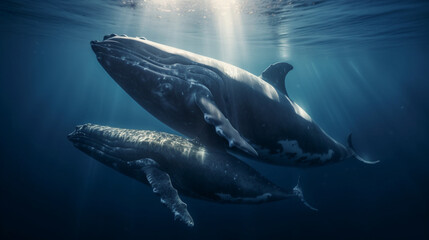Whales are among the most fascinating and majestic creatures in the ocean. Understanding female whales is essential for anyone interested in marine biology, wildlife conservation, or simply the wonders of the natural world. In this article, we will explore 15 facts about female whales, providing a detailed and engaging look at these incredible animals.
Table of Contents
Introduction to Female Whales
Female whales play a crucial role in the health and sustainability of whale populations. Their unique behaviors and characteristics set them apart from their male counterparts and are vital for the survival of their species. This article aims to shed light on these differences and offer a deeper understanding of the world of female whales.
Physical Characteristics
Size and Appearance
Female whales can vary significantly in size depending on the species. Generally, they are larger than males, a trait that aids in reproduction and nurturing young. For instance, the female blue whale is known to be the largest animal on the planet, reaching up to 100 feet in length.
Sexual Dimorphism
Sexual dimorphism is common in whales, meaning there are distinct differences in appearance between males and females. Female whales often have more rounded bodies, which help them carry and nourish their young.
Reproductive Biology
Breeding Cycles
Female whales typically have long and complex breeding cycles. For example, the gestation period for a female humpback whale is around 11 to 12 months. Understanding these cycles is essential for conservation efforts.
Calving
Calving is a critical part of a female whale’s life. Newborn calves rely heavily on their mothers for milk, protection, and guidance. Female whales give birth to one calf at a time, which ensures they can devote sufficient resources to each offspring.

Maternal Behaviors
Nurturing Young
Female whales are highly nurturing. They spend extended periods teaching their young essential survival skills, such as hunting techniques and navigation.
Protective Instincts
The protective nature of female whales is well-documented. They often form protective circles around their calves to shield them from predators and other threats.
Communication Skills
Vocalizations
Whales are known for their complex vocalizations. Female whales use sounds to communicate with their calves and other members of their pod. These sounds can range from clicks and whistles to elaborate songs.
Non-Verbal Communication
In addition to vocalizations, female whales use body language to communicate. Tail slaps, breaches, and pectoral fin waves are just a few examples of their non-verbal communication methods.
Social Structure
Matriarchal Pods
Many whale species, such as orcas, have matriarchal social structures. This means that older, experienced females lead the pod, making crucial decisions about hunting and migration.
Bonding and Relationships
Female whales form strong bonds with other females in their pod. These relationships are vital for the social cohesion and success of the group.
Migration Patterns
Seasonal Migrations
Female whales undertake long migrations between feeding and breeding grounds. These migrations are often timed to coincide with the availability of food and the need to give birth in warmer waters.
Navigational Skills
The ability of female whales to navigate across vast oceans is remarkable. They use a combination of the earth’s magnetic field, water currents, and possibly even the stars to find their way.
Diet and Feeding Habits
Diverse Diets
The diet of female whales varies by species. Baleen whales, like the humpback, filter feed on small fish and krill, while toothed whales, like orcas, hunt larger prey such as seals and dolphins.
Foraging Techniques
Female whales employ sophisticated foraging techniques. For example, humpback whales use bubble net feeding to corral and capture schools of fish.
Lifespan and Longevity
Longevity
Female whales generally live longer than males, with some species reaching over 90 years of age. The female bowhead whale, for instance, can live more than 200 years, making it one of the longest-lived mammals.
Aging and Reproduction
As female whales age, their reproductive capabilities change. Older females often play crucial roles in their pods, providing knowledge and leadership.
Threats and Conservation
Human-Induced Threats
Female whales face numerous threats from human activities, including ship strikes, entanglement in fishing gear, and habitat destruction. These threats significantly impact their populations and the overall health of marine ecosystems.
Conservation Efforts
Conservation efforts are critical for protecting female whales. Initiatives include establishing marine protected areas, regulating ship traffic, and funding research on whale behavior and biology.
Species Variations

Different Species
There are over 90 species of whales, each with unique characteristics. Some notable examples include the blue whale, humpback whale, and orca. Each species exhibits different behaviors and adaptations that are fascinating to study.
Adaptations
Female whales have adapted to their environments in various ways. For example, the female gray whale undertakes one of the longest migrations of any mammal, traveling from the Arctic to the warm lagoons of Mexico to give birth.
Intelligence and Problem Solving
Cognitive Abilities
Female whales are highly intelligent. They display problem-solving skills, use tools, and have complex social structures that require advanced cognitive abilities.
Learning and Memory
Research shows that female whales have excellent memories. They can remember migration routes and recognize individual members of their pod, even after long separations.
Role in Ecosystems
Ecological Impact
Female whales play a significant role in marine ecosystems. Their feeding habits help regulate fish populations, and their movements distribute nutrients throughout the ocean.
Whale Falls
When a whale dies, its carcass sinks to the ocean floor, creating a “whale fall.” This event provides a rich source of nutrients for deep-sea organisms, illustrating the vital ecological role of whales even after death.
Human Interactions
Whale Watching
Whale watching is a popular activity that allows people to observe whales in their natural habitat. This can help raise awareness and support for conservation efforts, especially when focused on understanding and protecting female whales.
Research and Collaboration
Scientists and conservationists work together globally to study and protect female whales. These efforts include tagging and tracking programs, genetic studies, and international treaties.
Future Research Directions
Emerging Technologies
Advancements in technology are opening new avenues for research on female whales. Drones, satellite tags, and underwater microphones are just a few tools helping researchers gain new insights into whale behavior and biology.
Conservation Priorities
Future research will continue to prioritize understanding the impacts of climate change, pollution, and human activities on female whale populations. These efforts are crucial for developing effective conservation strategies.
Behavioral Patterns of Female Whales
Female whales exhibit fascinating behavioral patterns that are critical for their survival and the well-being of their pods. These behaviors are often shaped by their need to care for their young, maintain social bonds, and adapt to changing environmental conditions.
Nurturing and Teaching
One of the most remarkable aspects of female whale behavior is their role as caregivers and educators. Female whales invest significant time and energy in nurturing their calves. They teach their young essential skills such as how to find food, avoid predators, and navigate the vast oceans. This education is vital for the calves’ survival and helps them integrate into their social groups.
Social Learning
Female whales engage in social learning, where they learn from observing and imitating others. This ability to learn from their peers is especially evident in species like orcas, where pods have been observed using unique hunting techniques that are passed down through generations. These techniques can include complex strategies like creating waves to wash seals off ice floes or herding fish into tight balls for easier capture.
Role in Pod Leadership
In many whale species, older females often assume leadership roles within their pods. These matriarchs use their experience and knowledge to guide the group, making crucial decisions about migration routes, hunting grounds, and social interactions. Their leadership ensures the pod’s cohesion and increases the chances of survival for all members.

Vocal Communication
Female whales are highly vocal animals, using a range of sounds to communicate. These vocalizations can serve various purposes, including coordinating group movements, maintaining social bonds, and attracting mates. Each species has its own repertoire of sounds, and some, like humpback whales, are known for their complex and haunting songs that can travel vast distances underwater.
Adaptation to Environmental Changes
Female whales demonstrate remarkable adaptability to environmental changes. For instance, they may alter their migration patterns in response to shifting ocean currents, temperature changes, and prey availability. This flexibility is crucial in an era of rapid climate change, as it allows them to find new feeding grounds and safe calving areas.
Cultural Transmission
Cultural transmission is a fascinating aspect of whale behavior, where knowledge and behaviors are passed down from one generation to the next. This phenomenon is particularly well-documented in orcas, where different pods have distinct cultures, including unique hunting methods and vocal dialects. Female whales play a key role in preserving and transmitting this cultural knowledge.
Long-Term Memory
Female whales possess impressive long-term memory, which helps them remember the locations of feeding grounds, migration routes, and social connections. This memory is not only beneficial for their survival but also for maintaining the stability and structure of their pods.
Impact of Human Activities
Human activities significantly impact female whales, influencing their behavior and survival. Noise pollution from ships and industrial activities can disrupt their communication and navigation, making it harder for them to find food and mates. Additionally, climate change affects the availability of prey, forcing whales to adapt to new feeding grounds or face food shortages.
Efforts to Mitigate Human Impact
Conservationists and researchers are working to mitigate the impact of human activities on female whales. Measures include implementing ship speed limits in areas frequented by whales to reduce the risk of collisions, creating marine protected areas, and promoting sustainable fishing practices to ensure sufficient prey availability. Public awareness campaigns also play a vital role in educating people about the importance of protecting these magnificent creatures.
Whale Watching and Conservation
Whale watching can be both a recreational activity and a tool for conservation. When conducted responsibly, it raises awareness about the importance of protecting whale populations and their habitats. Tour operators are encouraged to follow guidelines that minimize disturbances to the whales, ensuring that these encounters are safe and sustainable.
Research and Citizen Science
Ongoing research is essential for understanding the complex lives of female whales and developing effective conservation strategies. Scientists use various methods, including satellite tracking, acoustic monitoring, and photo identification, to study whale behavior, migration, and population dynamics. Citizen science initiatives, where volunteers contribute to data collection and monitoring efforts, also provide valuable support to researchers.
Future Challenges and Opportunities
The future of female whales depends on our ability to address the challenges they face. Climate change, pollution, and habitat loss are significant threats that require global cooperation and innovative solutions. By advancing scientific research, implementing effective conservation measures, and fostering public awareness and engagement, we can help ensure that female whales continue to thrive in our oceans for generations to come.
The world of female whales is rich with complexity and wonder. Their behaviors, social structures, and adaptations highlight their importance in marine ecosystems and the need for dedicated conservation efforts. By deepening our understanding and taking action to protect these magnificent creatures, we contribute to the health and diversity of our planet’s oceans.
conclusion
Understanding 15 facts about female whales gives us a deeper appreciation of these incredible creatures. Their unique physical characteristics, reproductive biology, and social structures highlight their importance in the marine ecosystem. By learning more about female whales, we can better appreciate the need for their conservation and take action to protect them for future generations.
To learn more about the fascinating world of female whales, consider supporting marine conservation organizations and participating in whale watching tours that promote sustainable practices. Your involvement can make a significant difference in preserving these majestic creatures and their habitats.




























































